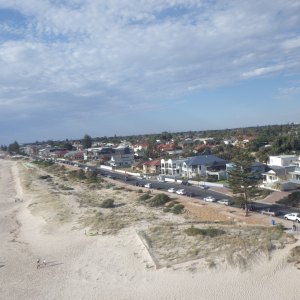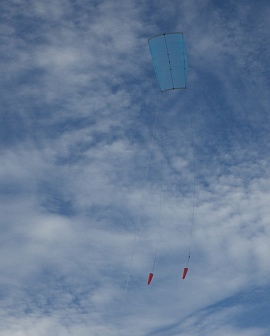- Home Page
- Aerial Photos
- Brighton Beach
Brighton Beach
KAP Report
 Brighton Beach
Brighton BeachRain and strengthening winds had been forecast for the next few days. So with the sun still shining, it was time to head out for some KAP (kite aerial photography).
Brighton Beach had been visited a couple of times before, but without success. Oh, I got a short-format flight report or two out of the trips but no great series of KAP photos for one reason or another.
Today, going by online weather reports, wind gusts of up to 20 kph could be expected. That was at the airport station, a couple of suburbs away from Brighton. It looked like an afternoon for the big Multi-Dowel Barn Door kite.
The Multi-Dowel Sled was selected as the backup
kite, in case the breeze got too light for the barn door. On the other
hand, if things got fresher, the Fresh Wind Barn Door also happened to
be in the car. It pays to be well prepared.
Well, the breeze did start to look lighter on the way to the beach! As it turned out, the wind lightened up even further throughout the session.
On this site, there's more kite-making info than you can poke a stick at. :-) Want to know the most convenient way of using it all?
The Big MBK E-book Bundle is a collection of downloads—printable PDF files which provide step-by-step instructions for many kites large and small.
That's every kite in every MBK series.
Weather
The panorama below shows the beach from where I was flying. In the enlarged image, see if you can spot the person walking their dog, who managed to appear in both frames 1 and 2! It takes me a few seconds to line up each of the three shots, you see. In the meantime, objects move about.
Cloud cover was extensive but fairly thin by the time the kite flew. To my relief, fairly strong sunshine was peeping through from time to time. At least a few frames would be able to take advantage, since they fired off every ten seconds.
Air temperature had peaked at around 30 degrees earlier in the day. With all the cloud around, it was not much cooler by late afternoon when the KAP rig was aloft.
A light south-southwest breeze gusted in from over the sea, reaching perhaps 12 kph at first but gradually lightening up as time passed. In fact, the breeze was extremely light at times at ground level. After packing up, a quick check with the meter showed only 3.3 kph gusting to 3.8 kph!
KAP Equipment
 MBK Multi-Dowel Sled
MBK Multi-Dowel SledLifter: The Multi-Dowel Sled kite, with drogues attached. Interestingly, the kite did not take kindly to having the KAP rig only 15 meters (50 feet) away today—instead of my usual 30 meters (100 feet). I hate to think what might have happened if the drogues had not been attached! Despite some excessive swinging around, fast shutter speeds still saved the day. All the shots were sharp.
Take a look at my e-book Making Dowel Kites if you would like to put together your own big sled. Or you could try some other design; the barn-door kite is a good KAP workhorse too.
KAP Rig:
Bamboo-skewer cage with glued-in paddle-pop sticks behind the camera to
incline the field of view down a little. The suspension was half-Picavet as
usual these days. On the second flight, I adjusted the camera's
direction a little since it seemed to be pointing too far inland.
Camera: Pentax Optio WG-2 with built-in intervalometer. Two sets of 20 shots (at ten-second intervals) were done today. EV was at first set to -0.3 and then changed to -1.0. ISO was fixed on 200. Focus was fixed on infinity.
Images
The first image below is from the first flight, while the others are from the second flight of the big sled kite. They show the camera's view from various altitudes, looking mainly straight up the beach—except when some rig swing brought the jetty into view!
The highest view was from just over 200 feet above the sand.
Click on a thumbnail image below to see it much larger:
Flight Report
The usual flying-line storage for KAP has been my trusty but awkward-to-carry hose reel. The reel is loaded with 200-pound braided Dacron, which is more than ample in strength for any of my kites. Today it was decided to fly on 90-pound Dacron on a flat winder. That was not so convenient to get the line out quickly, but it could be carried onto the beach inside my gear bag. Strength-wise, it would be fine in the very light breeze—even with "The Horse" (the big sled) stretching it taut!
After selecting a launch site on the sand, I got busy with taking
several panoramas. These consisted of three frames each, stitched together by the camera.
The little marked chair helped with camera alignment as usual.
Soon
the suspension lines were hooked on and camera inserted into the
cradle. As always, the sled was easy to rig. This included securing each
drogue line to a lower corner of the kite with a single half-hitch.
Holding the kite on 15 meters (50 feet) of line, I used an elbow and an arm to
tweak the cradle around until it faced the proper direction. That was straight
down the beach in a roughly downwind direction. There would be no
flying line making an appearance in these shots!
This was the
first flight of the cradle with paddle-pop sticks taking the place of
the usual thickly folded piece of paper. The permanently mounted sticks
performed the same function—tilting the field of view down a little, so
more ground than sky would fill the frame for most shots.
The camera was set to a fixed ISO of 200 and EV of -0.3.
Within
half a minute it was clear that the big sled did not like the
suspension point being just 15 meters (50 feet) from the kite—at least in
fairly light air. The cradle hardly stopped its pronounced swinging
during the ascent. This was despite decent line tension and the twin drogues
doing their best to stop the kite's tail end from moving side to side.
The
oscillations didn't get any worse, so I continued with the flight; the kite went out
to 90 meters (300 feet) of line and a 45-degree flight angle. With more line out,
the situation improved a little—but only a little.
Having
allowed plenty of time for the camera to stop shooting, the kite was
brought in. It happily flew on 15 meters (50 feet) from three turns around my left
shoe while I changed the camera's EV setting to -1.0 for the second
flight. This time I managed to get the camera away a bit quicker,
bringing it to near maximum height before the four-minute initial delay
timed out. After that, it was taking one photo every ten seconds as
usual.
This time I backed away, right to the water's edge, and let
out a few extra meters of line. So the kite was flying on roughly 100 meters
(330 feet) and was still at about 45 degrees of angle. Or perhaps it was a fraction less, as
the wind speed was now very marginal. I was so glad the sled was up! The
barn door would have really started to struggle by this stage.
Eventually,
the swinging camera was brought down and removed from the cradle with
no problems. Finally relieved of the KAP-rig pendulum, the sled just
parked itself at a high angle on the short line, almost motionless above
the sand. The tide was coming in. After the briefest of thoughts about
doing a third flight, it instead seemed like a good decision to "quit
while I was ahead"!
A guy walked over, inquiring about the kind
of kite that was now laid out on the sand. "An Allison Sled" was my
reply. On getting closer and taking a look, he said "OH—a homemade
job!". After a short conversation, I handed him a small flyer which
identified myself and the website.
Not long afterward, the phone
in my pocket vibrated as the kite widow tried to make contact. I'm just
kidding; although she could not be called a kiting enthusiast, my wife,
May, did actually fly her own $5 ship kite the other day.
It was a fairly relaxed KAP session in the end, despite the initial concerns about the swinging rig!
The story or stories above document actual flying experiences. My write-ups are definitely "warts and all," since things don't always go totally as planned. However, half the fun of kiting is anticipating the perfect flight. When it happens, it's magic!
As mentioned earlier, there's more kite-making info here than you can poke a stick at. :-)
Want to know the most convenient way of using it all?
The Big MBK E-book Bundle is a collection of downloads—printable PDF files which provide step-by-step instructions for many kites large and small.
That's every kite in every MBK series.





